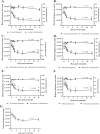TECHNICAL NOTE: Analysis of volatile fatty acids in rumen fluid by gas chromatography mass spectrometry using a dimethyl carbonate extraction
- PMID: 35660871
- PMCID: PMC9412176
- DOI: 10.1093/jas/skac207
TECHNICAL NOTE: Analysis of volatile fatty acids in rumen fluid by gas chromatography mass spectrometry using a dimethyl carbonate extraction
Abstract
Analysis of rumen fluid volatile fatty acids (VFA) is typically conducted by injecting acidified aqueous rumen fluid into a gas chromatograph (GC) with a flame ionization detector (FID). Aqueous samples are highly problematic because of the large vapor volume that can lead to poor peak shape and contamination of inlets, potentially causing sample carryover. Methods using aqueous samples are not well suited for use in a mass spectrometer (MS) detector system. The objective of this project was to validate a dimethyl carbonate (DMC) extraction process and GCMS method for rumen VFA analysis. To perform the extraction, 100 µL of sample, KHSO4 (500 g/L), and 2-ethylbutyrate (internal standard; 8.5 mM) were added to a microcentrifuge tube (in order) followed by 1 mL of DMC. The mixture was thoroughly vortexed and centrifuged. The organic layer (top) was removed and placed in a GC vial. The DMC extract was injected (0.5 µL) into an Agilent 5977B GCMS (8:1 split injection) with a polar DB-FFAP column. The column was held at 105 °C for 5 min, increased at 10 °C/min to 150 °C, then 65 °C/min to 240 °C, and held constant for 10 min. The peak area of acetate relative to the internal standard is linear from approximately 2 mM to at least 130 mM and encompasses the expected values of rumen concentrations for the other VFA. Recovery of VFA from spiked rumen fluid was tested at three concentrations in rumen fluid from steers fed a finishing diet or grazing wheat pasture. Recovery was not affected by the diet of the animals (P > 0.10) or the amount of VFA spiked (P > 0.19) for acetate, propionate, isobutyrate, or butyrate. There was an interaction of amount of VFA spiked and the diet of the animal (P = 0.021) for valerate and a tendency for an interaction (P = 0.051) for isovalerate, due to the recovery of the VFA being lower in the medium spike amount in rumen fluid from cattle on wheat pasture. Overall, recovery was greatest for propionate (101.9 ± 1.67%) and lowest for valerate (95.7 ± 1.95%). Including the 10-min hold at 240 °C at the end of each run prevented carryover from sample to sample. This method appears to perform well in a GCMS system and accurately and precisely quantifies rumen fluid VFA.
Keywords: VFA analysis; gas chromatography; mass spectrometer.
Plain language summary
Scientists need to measure the end-products of microbial digestion called volatile fatty acids in the gastrointestinal tract of ruminants for many reasons. The methods currently available for the analysis of volatile fatty acids have evolved over time along with new technology. Many of the methods available are either not compatible with a mass spectrometer detector or require hazardous chemicals to prepare the samples. The method described here uses a less-hazardous chemical to prepare the samples for analysis with a mass spectrometer detector. The method tested in this manuscript was adequate in preparing samples for volatile fatty acid analysis.
© The Author(s) 2022. Published by Oxford University Press on behalf of the American Society of Animal Science. All rights reserved. For permissions, please e-mail: journals.permissions@oup.com.
Figures



References
-
- Aeppli, C., Berg M., Hofstetter T. B., Kipfer R., and Schwarzenbach R. P... 2008. Simultaneous quantification of polar and non-polar volatile organic compounds in water samples by direct aqueous injection-gas chromatography/mass spectrometry. J. Chromatogr. A 1181:116–124. doi:10.1016/j.chroma.2007.12.043. - DOI - PubMed
-
- Erwin, E., Marco G. J., and Emery E... 1961. Volatile fatty acid analyses of blood and rumen fluid by gas chromatography. J. Dairy Sci. 44:1768–1771. doi:10.3168/jds.S0022-0302(61)89956-6. - DOI
MeSH terms
Substances
LinkOut - more resources
Full Text Sources
Miscellaneous

